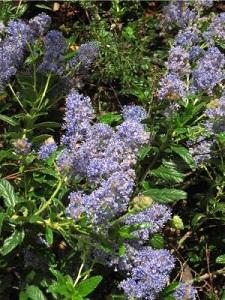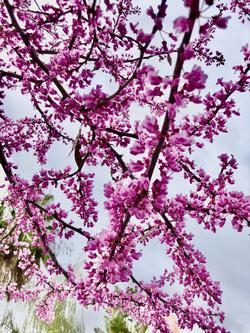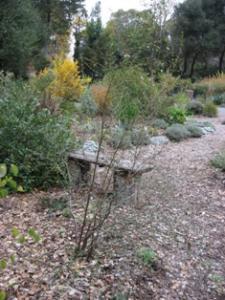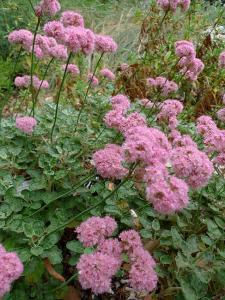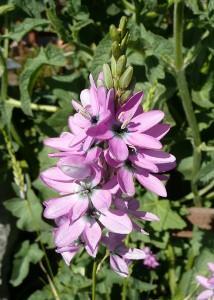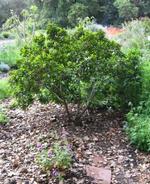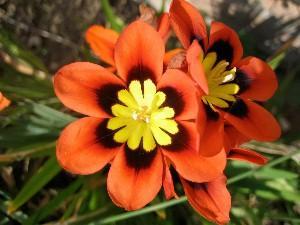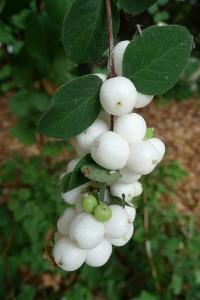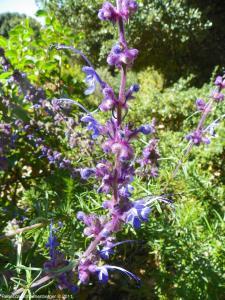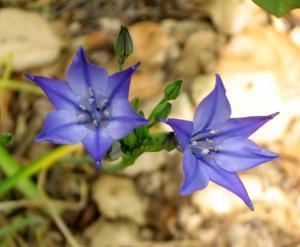Water Wise Plants
Here's a full list of all our water wise plants. You can also view an image gallery, or view the plants by categories.
Ceanothus
Pronunciation
see-ah-NO-thuss
Common Name
California Wild Lilac
Plant Type
Plant type depends on cultivar
Mature Size
Many different types
Water Requirements
None: avoid summer water
Sun/Shade Requirements
Full to half sun
Wildlife
Flower Color
Purple, dark blue, medium blue, white
Where to See
Maintenance- Design- Planting Tips
Ceanothus is a California native evergreen shrub. It is very showy in late winter and early spring when it covers itself with beautiful blossoms. Most Ceanothus have blue blooms that are very attractive to bees and other insects.
There are many different kinds of Ceanothus. Some are low growing ground covers; some are shrubs, and some become tree-like. Most Ceanothus need to be planted in a dry part of the garden because they are very sensitive to summer watering. Ceanothus varieties originally from the coast, such as ‘Carmel Creeper’, are more tolerant of summer water. Cultivars should be researched carefully to select the right plant that meets individual garden conditions. It is best to prune Ceanothus in the late summer when they are dormant. Take care not to cut into large branches. Only prune branches that are an inch or less in size. Even with proper pruning and watering, these plants can be short-lived (five to ten years), but their beautiful spring flowers more than make up for any challenges. |
Cercis occidentalis
Pronunciation
SIR-sis ok-sih-den-TAY-liss
Common Name
Western Redbud
Plant Type
Shrub
Mature Size
12-20 ft. tall and wide
Water Requirements
None: avoid summer water
Sun/Shade Requirements
Full to half sun
Wildlife
Flower Color
Magenta
Where to See
Maintenance- Design- Planting Tips
Western redbud's magenta flowers are quite a sight in the early spring. After blooming the small multi-trunked tree or large shrub has pretty heart-shaped leaves. This California native and UC Davis Arboretum All-Star is an excellent choice for a small space or an edge of woodland design. After the plant blooms, Western redbud sets distinctive seedpods.
Like many natives, this plant needs good drainage, so consider planting it on a mound. Avoid summer water. Cercis can be pruned over the winter to open up the branching structure to give the plant a more tree-like appearance. |
Cercocarpus betuloides
Pronunciation
ser-koe-KAR-pus be-tull-OY-dees
Common Name
Mountain Mahogany
Plant Type
Shrub
Mature Size
5-12 ft. tall and wide, adult size can vary
Water Requirements
None: avoid summer water
Sun/Shade Requirements
Full to half sun
Wildlife
Flower Color
Small yellow flowers
Where to See
Maintenance- Design- Planting Tips
Cercocarpus is an evergreen shrub that is useful for screening, as informal hedging, or can be pruned into a small, elegant tree. As a California native from the foothills, it can get by on little to no water once established. It is on the UC Davis Arboretum All-Stars list.
PADG notes: This slow growing plant has not had problems with pests or diseases. We have pruned this Cercocarpus to have a more open form, so it is now a very attractive, airy shrub. |
Eriogonum grande var. rubescens
Pronunciation
ee-ree-OG-oh-num GRAHN-day roo-BESS-ens
Common Name
Rosy Buckwheat
Plant Type
Shrub
Mature Size
1 ft. to 2 ft. tall and wide
Water Requirements
None: avoid summer water
Sun/Shade Requirements
Full sun
Wildlife
Flower Color
Maintenance- Design- Planting Tips
Rosy buckwheat, a California native from the Channel Islands, has rosy flowers in summer. It is one of the showiest and most compact of the buckwheats. Because of its size and neat growth habit, it makes a great filler plant in a native garden. Rosy buckwheat shines in late summer when the flowers turn from rosy to a coppery tint. The mellow colors of this plant blends well with other perennials. At the end of the coppery color phase, the blooms can be deadheaded to avoid a ratty look. Every few years, do a light pruning to new growth below the taller branches. The best time to do this pruning is in the late fall before the winter growth starts. Shape this plant every so often to keep its mounding form. Buckwheat requires some summer water the first year it is planted. After the first year, avoid summer water. The plants may only live three to five years, though sometimes longer. It freely reseeds so buying new plants may not be necessary. |
Ixia
Pronunciation
IKS-ee-uh
Common Name
African Corn Lily
Plant Type
Bulb
Mature Size
18 - 20 in. tall
Water Requirements
None: avoid summer water
Sun/Shade Requirements
Full sun
Wildlife
Flower Color
Cream, yellow, red, orange, and pink
Where to See
Maintenance- Design- Planting Tips
This versatile South African bulb is one of the best kept secrets of a Mediterranean garden. The late spring flowers come in pretty jewel tone colors that go well with many spring-blooming plants. The grass-like foliage on this plant can be removed when it goes brown and dormant in the summer. While it prefers no summer water, it can tolerate some.
|
Rhamnus californica 'Mound San Bruno'
Pronunciation
RAM-nus kal-ih-FOR-nik-uh
Common Name
Coffeeberry 'Mound San Bruno'
Plant Type
Shrub
Mature Size
5 ft. tall and wide
Water Requirements
None: avoid summer water
Sun/Shade Requirements
Full to half sun, shade
Wildlife
Flower Color
Inconsequential pale yellow
Where to See
Maintenance- Design- Planting Tips
Coffeeberry isn't a flashy shrub, but it does add much needed structure to the native plant bed. The berries on the plant are attractive and beneficial for birds and small mammals.
There are many different varieties of coffeeberry. They can be used as an informal hedge or screen or gently pruned to be a bedding or foundation shrub. 'Mound San Bruno' has a compact growing habit that works well in a perennial bed. PADG notes: The California native coffeeberry 'Mound San Bruno' was planted in a native plant bed that receives both sun and shade. The amount of sun the bed gets varies depending on the time of year and time of day. That's a common condition in many gardens and not all shrubs do well in both sun and shade. The coffeeberry was watered once a week to get it started, but now that it is established, it is only watered once or twice over the summer to wash the dust off the leaves. |
Sparaxis tricolor
Pronunciation
spa-RAKS-iss
Common Name
Harlequin Flower
Plant Type
Bulb
Mature Size
8-12 in. wide and 12 in. tall
Water Requirements
None: avoid summer water
Sun/Shade Requirements
Full sun
Wildlife
Flower Color
Red, pink, purple, while and yellow
Where to See
Maintenance- Design- Planting Tips
Sparaxis is a South African bulb with cheerful flowers and sword-shaped leaves. They come in an assortment of colors and look spectacular in a mixed planting. Best of all, they don't need summer water, but will tolerate water if irrigated.
Sparaxis is truly an easy plant that has few insect or disease problems and will naturalize without effort. The plants readily self sow. If leaves are left on until the seed pods open, more plants will grow the next year. These plants go dormant after blooming. PADG notes: After the leaves have lost most of their green color, they are snipped off a couple inches of above ground. Other master gardeners wait for the leaves to go completely brown and then they simply pull off the dead leaves. It isn't necessary to do this, but getting rid of brown dormant leaves gives the summer garden a more lush look. Unfortunately, snails and slugs love these plants. The leaves will generally show it unless snails are kept under control. |
Symphoricarpos albus
Pronunciation
sim-for-ih-KAR-pus AL-bus
Common Name
Snowberry
Plant Type
Shrub
Mature Size
3 - 5 ft. tall and wide
Water Requirements
None: avoid summer water
Sun/Shade Requirements
Full to half sun, shade
Wildlife
Flower Color
Where to See
Maintenance- Design- Planting Tips
When fall and winter come, shrubs with berries and fruit add interest to the garden. Snowberry, a California native, has white berries that show up in the fall and last through winter. These berries are attractive to birds too.
One of the best features of snowberry is it does well in dry woodland conditions. It is a rare shrub that will thrive under a thicket of oak trees. Some people find the branching structure of snowberry to be messy. California Native Plants for the Garden recommends occasional coppicing to improve its appearance. Coppicing means to cut back a plant to about one foot from the ground. This usually works best right before a plant puts out new growth in the spring. PADG Notes: Our snowberries grow in a shady area that gets no summer irrigation.
|
Trichostema lanatum
Pronunciation
try-CO-stem-uh la-NAY-tum
Common Name
Woolly Blue Curls
Plant Type
Shrub
Mature Size
3-4 ft. high & wide
Water Requirements
None: avoid summer water
Sun/Shade Requirements
Full sun
Wildlife
Flower Color
Violet to blue
Where to See
Maintenance- Design- Planting Tips
PADG Notes: We approached growing the California native Woolly Blue Curls with some trepidation because it has a reputation for being difficult. It is sensitive to over watering and poor draining soil and often is short lived. But it has beautiful flowers and foliage that smells like bubble gum when rubbed.
Several years ago, a Woolly Blue Curls plant was added to our California native plant bed. The plant was mulched with rock to improve drainage and received no additional summer water. It has bloomed and grown over the years, but it really wants a sunnier spot. The plant is reaching out for more light and has woody, unattractive stems. We’ve avoided cutting the plant back hard, because we have read it does not get new growth on old wood. Some sources suggest planting Woolly Blue Curls as an annual. In all honesty, if your heart is not set on a California native, there are probably easier low water plants with lavender flowers. Lavender and Mexican sage are two lavender flowered plants we think are safer choices for the novice gardener. |
Triteleia laxa ‘Queen Fabiola’
Pronunciation
trit-el-AY-ah LAKS-uh
Common Name
Triteleia 'Queen Fabiola'
Plant Type
Bulb
Mature Size
Flower stalks are 6 to 28 in. tall
Water Requirements
None: avoid summer water
Sun/Shade Requirements
Full to half sun
Wildlife
Flower Color
Where to See
Maintenance- Design- Planting Tips
Triteleia ‘Queen Fabiola’ is a California native bulb with purple blue flowers in the late spring and early summer. It has grass like leaves that go dormant in the summer. Triteleia 'Queen Fabiola' used to be called Brodiaea and many bulb catalogs still list it under that name.
PADG Notes: 'Queen Fabiola' has been planted in several beds on the edge of the garden that receive limited or no supplemental water. Because 'Queen Fabiola' has delicate flowers and blooms in the late spring when lots is going on in the garden, this bulb needs to be massed to make an impact. Avoid summer water especially in clay soil. We remove the brown leaves in the summer to keep a tidy look, but that's not necessary. |







